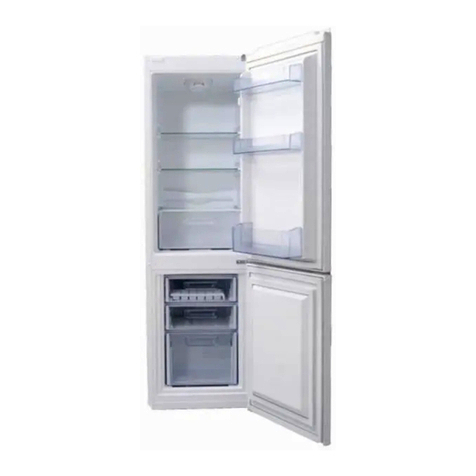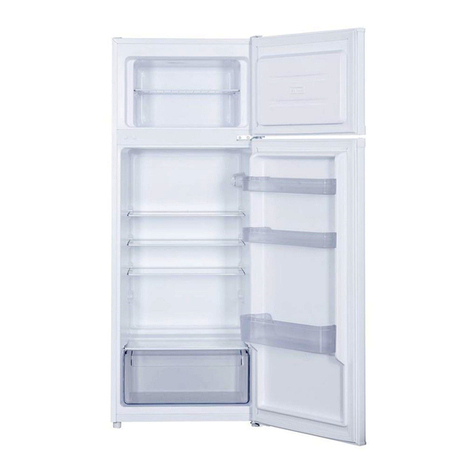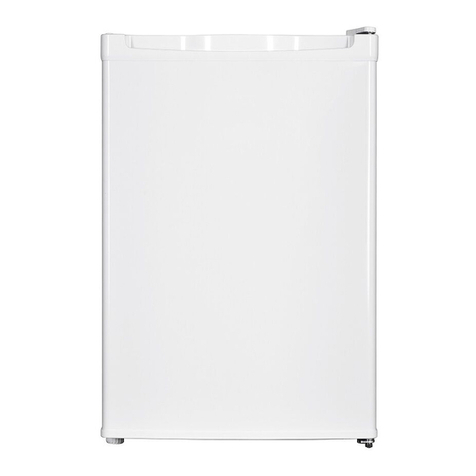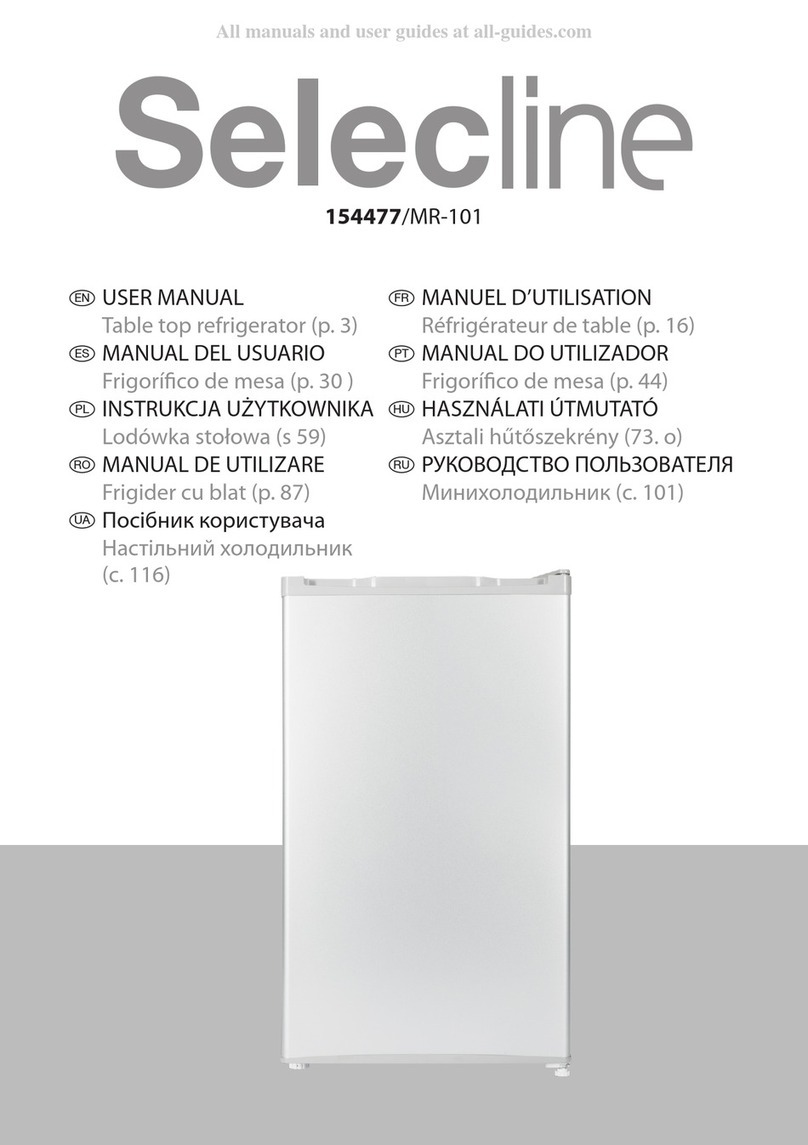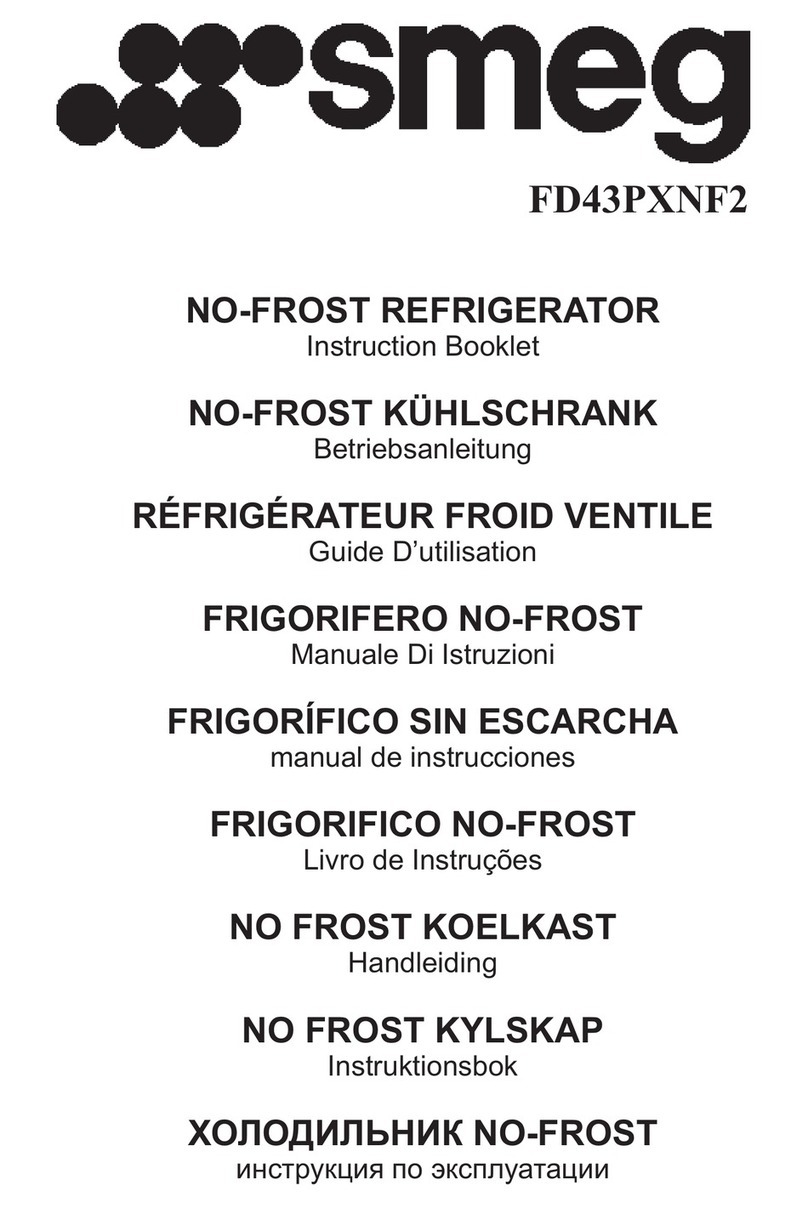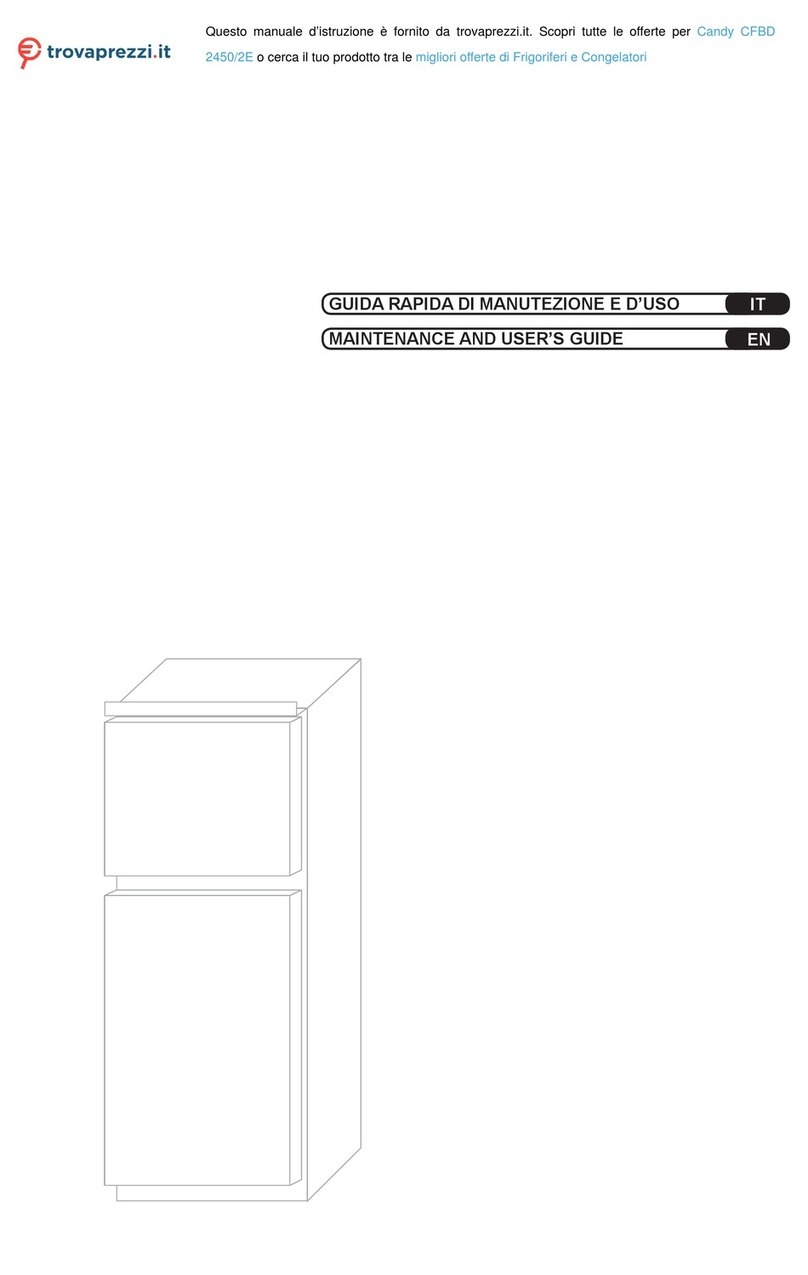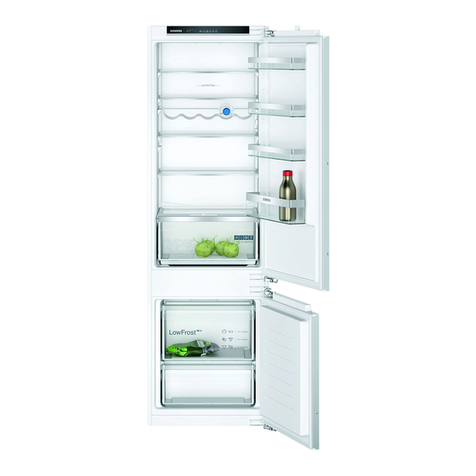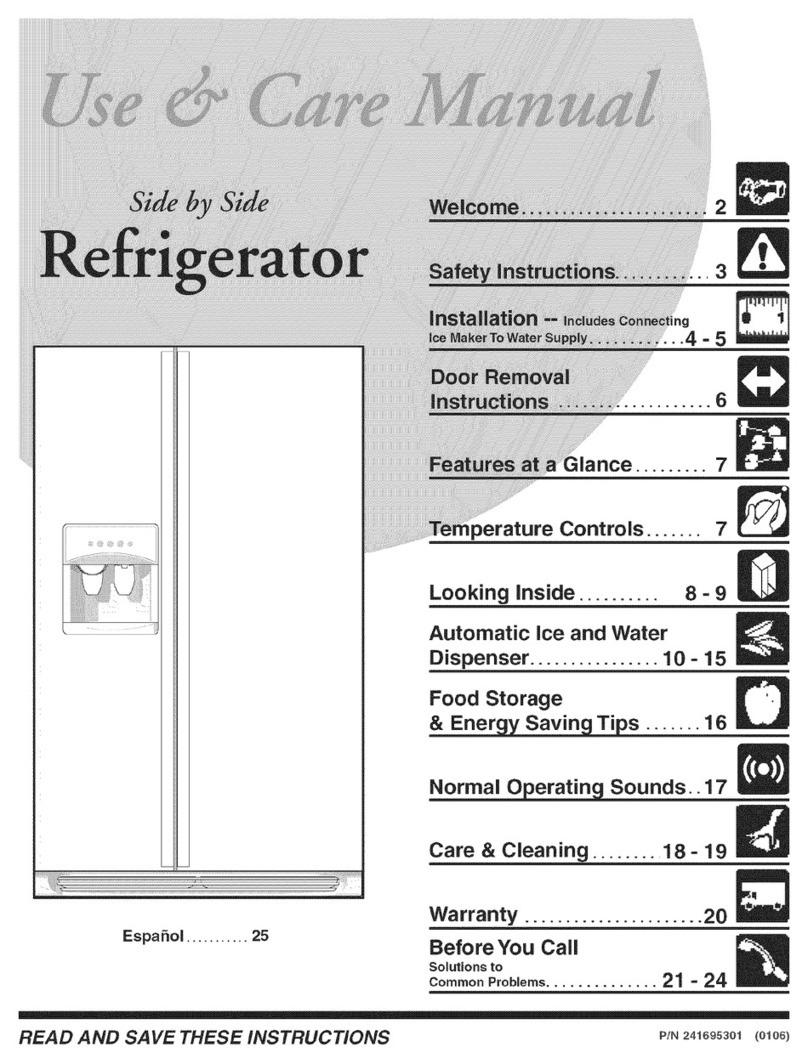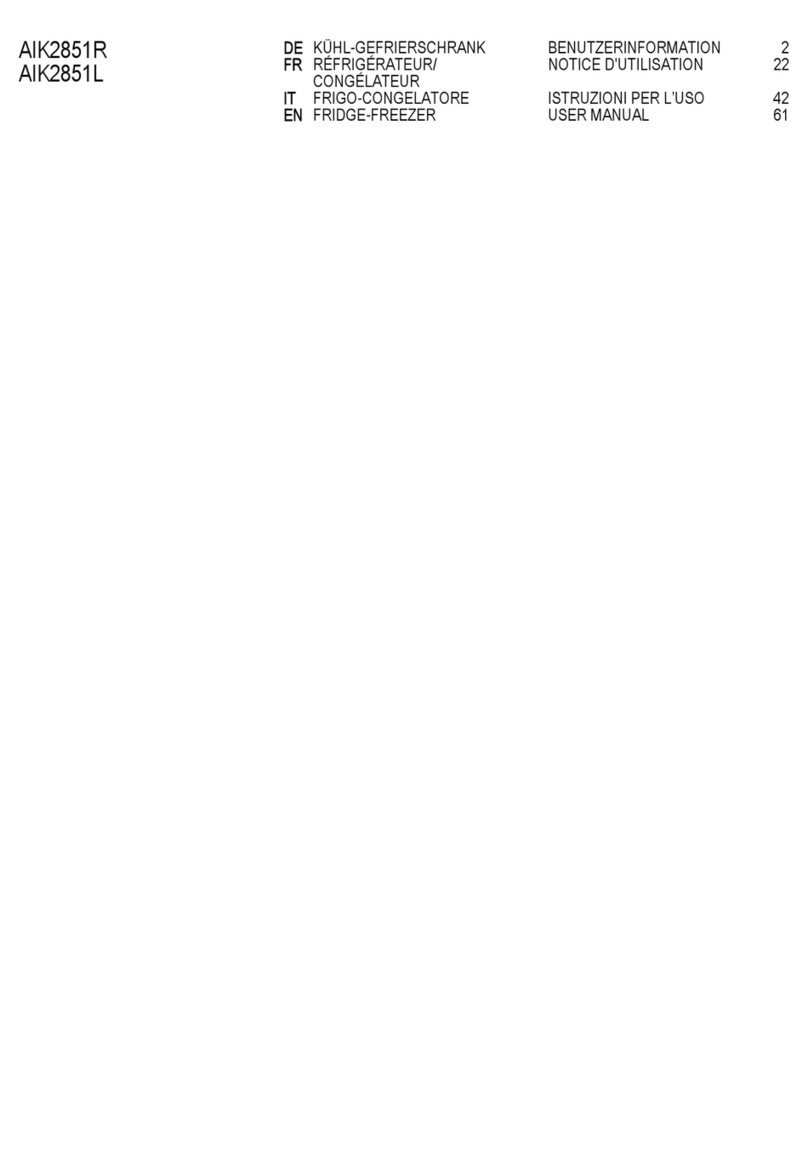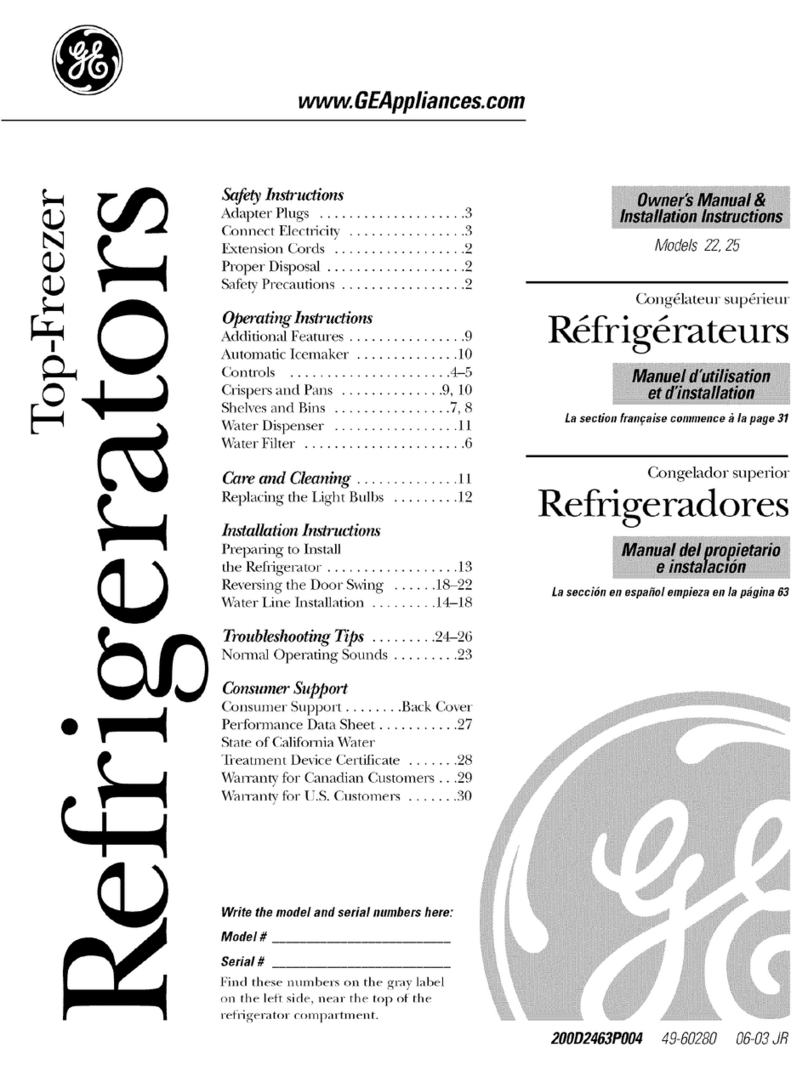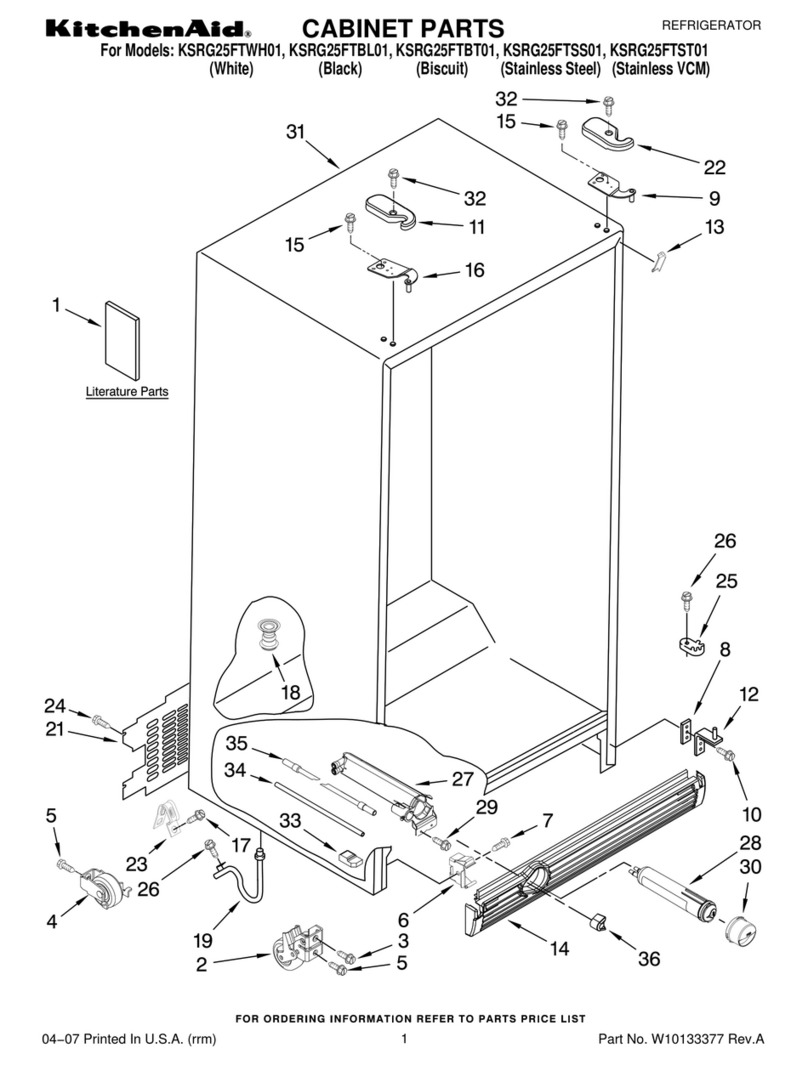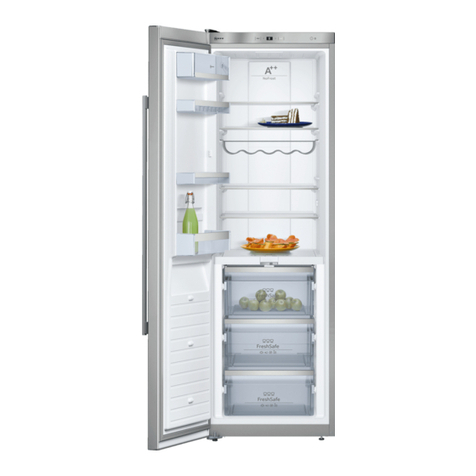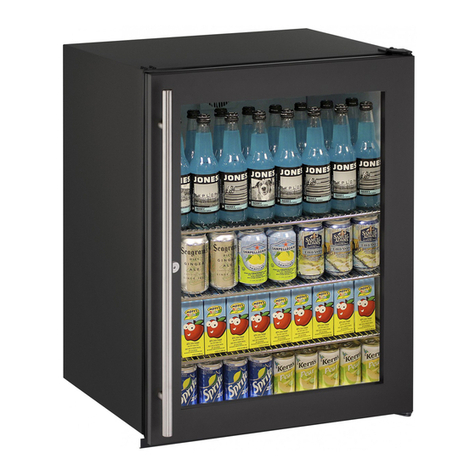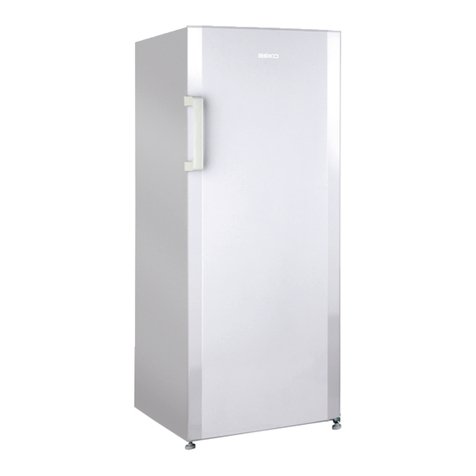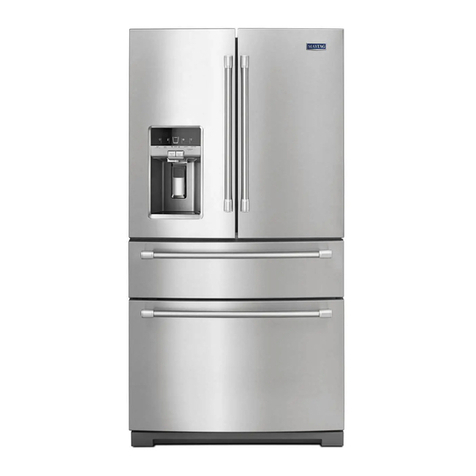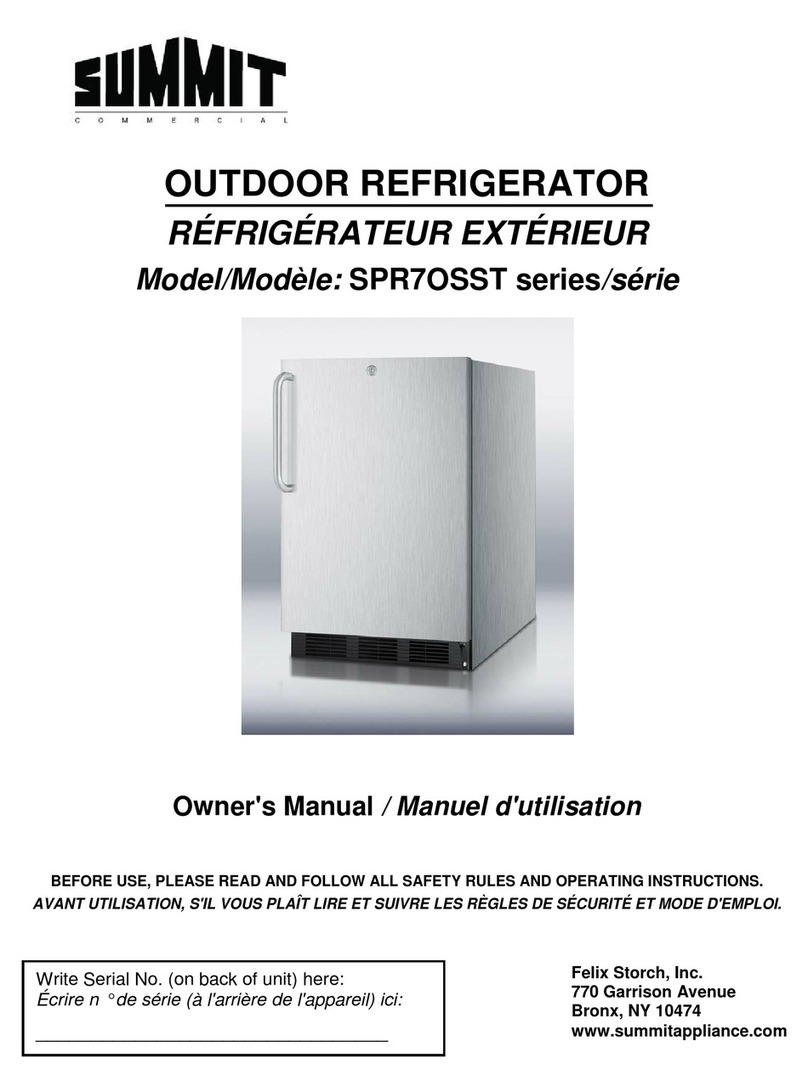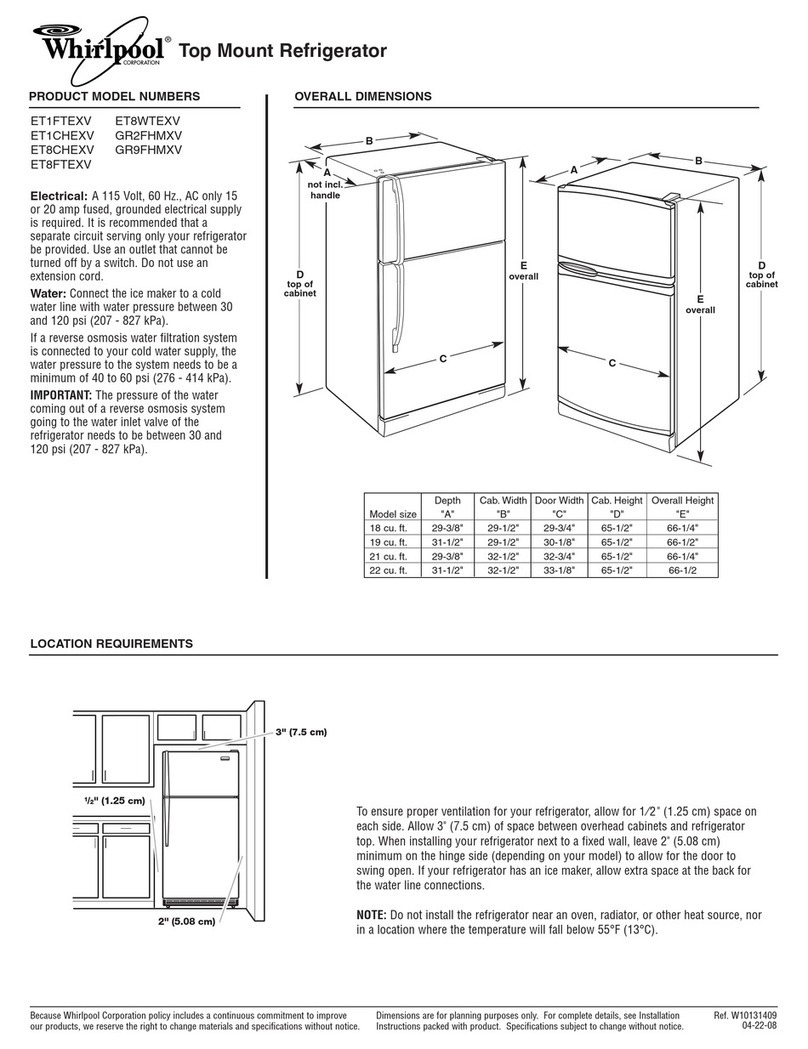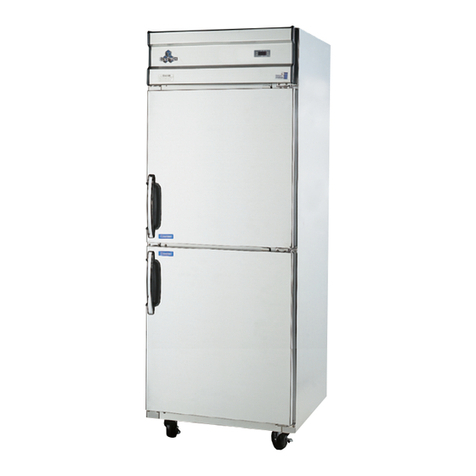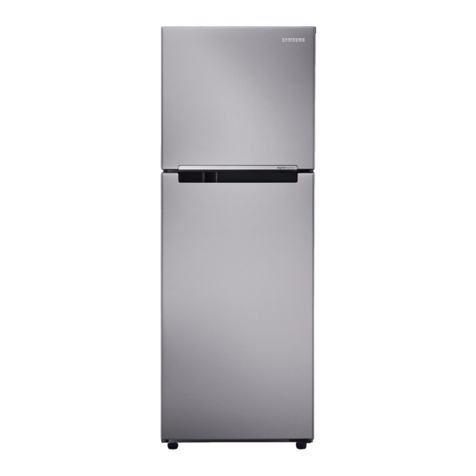Selecline MR-101 User manual

154477/MR-101
EN USER MANUAL FR MANUEL D’UTILISATION
Table top refrigerator (p. 3) Réfrigérateur de table (p. 16)
ES MANUAL DEL USUARIO PT MANUAL DO UTILIZADOR
Frigoríco de mesa (p. 30 ) Frigoríco de mesa (p. 44)
PL INSTRUKCJA UŻYTKOWNIKA HU HASZNÁLATI ÚTMUTATÓ
Lodówka stołowa (s 59) Asztali hűtőszekrény (73. o)
RO MANUAL DE UTILIZARE RU РУКОВОДСТВО ПОЛЬЗОВАТЕЛЯ
Frigider cu blat (p. 87) Минихолодильник (с. 101)
UA Посібник користувача
Настільний холодильник
(с. 116)

EN
2
3
4
7
5
6
1
FR
ES
PT
PL
HU
RO
RU
UA

EN
3
1/ SAFETY INFORMATION
Before using this electrical appliance, read the instructions
below and keep these instructions for future reference:
1. This appliance can be used by children aged from
8 years and above and persons with reduce physical,
sensory or mental capabilities or lack of experience
and knowledge if they have been given supervision
or instruction concerning the use of the appliance in a
safe way and understand the hazards involved.
2. Children shall not play with the appliance.
3. Cleaning and user maintenance shall not be made by
children without supervision.
4. This appliance is intended to be used in household and
similar applications such as
-staff kitchen areas in shops, offices and other working
environments;
-farm houses and by clients in hotels, motels and other
residential type environments;
-bed and breakfast type environments;
-catering and similar non-retail applications.
5. Thisproductisa householdrefrigeratorandshallbeonly
suitable for the storage of food and beverage. According
to national standards, household refrigerators shall not
be used for other purposes, such as storage of blood,
drugs or biological products.
TABLE OF CONTENTS:
1/ SAFETY INFORMATION ______________________________________________ P.3
2/ TECHNICAL DATA ___________________________________________________ P.7
3/ DESCRIPTION ______________________________________________________ P.7
4/ INSTALLATION _____________________________________________________ P.7
5/ USE ______________________________________________________________ P.10
6/ MAINTENANCE AND CLEANING_______________________________________ P.12
7/ TROUBLESHOOTING ________________________________________________ P.14
8/ WARRANTY AND LIMITATIONS OF LIABILITY ____________________________ P.15

EN
4
6. Warning: When positioning the appliance, ensure the
supply cord is not trapped or damaged.
7. The appliance cannot be built into furniture, wall or
similar locations.
8. Before connecting the appliance to an electrical outlet,
make sure that the local power supply corresponds
to that indicated on the rating label affixed to the
appliance.
9. A special plug is installed to the power cable of your
appliance. This plug must be plugged into a grounded
wall outlet with at least 16 A. If you should not have such
a wall outlet, have it installed by a qualified electrician.
10. Warning – Do not damage the refrigerant circuit.
11. The refrigerant gas R600a that is contained in the
refrigerator is a natural gas. It is not harmful to the
environment, but combustible. It is therefore important
to transport and install your refrigerator carefully so as
not to damage the refrigerant ducts. In the event of a
gas leak, avoid contact with nearby flames or fires and
ventilate the room.
12. Risk of electric shock! Do not try to repair the appliance
yourself. In case of malfunction, repairs must be carried
out by qualified personnel.
13. If the supply cord is damaged, it must be replaced by
the manufacturer, its service agent or similarly qualified
persons in order to avoid a hazard.
14. Warning – Keep ventilation openings, in the appliance
enclosureorinthebuilt-instructure,clearofobstruction.
15. Warning – Do not use mechanical devices or other
means to accelerate the defrosting process, other than
those recommended by the manufacturer.
16. Warning – Do not use electrical appliances inside the
food storage compartments of the appliance, unless
they are of the type recommended by the manufacturer.
17. Do not store explosive substances such as aerosol cans
with a flammable propellant in this appliance.

EN
5
18. Do not put flammable, explosive, volatile and highly
corrosive items in the refrigerator to prevent damages
to the product or fire accidents.
19. Do not place flammable items near the refrigerator to
avoid fires.
20. Do not place items such as bottled or sealed container of
fluid such as bottled beers and beverages in the freezer
compartment to prevent bursts and other losses.
21. The appliance has to be unplugged after use and before
carrying out user maintenance on the appliance.
22. Tips for cleaning the appliance can be found in the
“Cleaning and maintenance”chapter.
23. This marking indicates that this product should not
be disposed with other household wastes
throughout the EU. To prevent possible harm to
the environment or human health from uncontrolled
waste disposal, recycle it responsibly to promote the
sustainable reuse of material resources. To return your
used device, please use the return and collection
systems or contact the retailer where the product was
purchased.Theycantake thisproductforenvironmental
safe recycling.
24. Dispose of the appliance according to local regulations
as it uses flammable blowing gas and refrigerant.
25. Before scrapping the appliance, remove the doors to
prevent children from becoming trapped.
26. Risk of suffocation! Keep all packaging materials out of
the reach of children and babies!
27. Recycle packaging materials in accordance with
regulations. Ask your local authorities where collection
centres or waste disposal centres are located.
28. To avoid contamination of food, please respect the
following instructions:
-Opening the door for long periods can cause a significant
increase of the temperature in the compartments of the
appliance.

EN
6
-Clean regularly surfaces that can come in contact with
food and accessible drainage systems.
-Clean water tanks if they have not been used for 48 h; flush
the water system connected to a water supply if water has
not been drawn for 5 days.
-Store raw meat and fish in suitable containers in the
refrigerator, so that it is not in contact with or drip onto
other food.
-Two-star frozen-food compartments are suitable for
storing pre-frozen food, storing or making ice cream and
making ice cubes.
-One-, two- and three-star compartments are not suitable
for the freezing of fresh food.
-If the refrigerating appliance is left empty for long periods,
switch off, defrost, clean, dry, and leave the door open to
prevent mould developing within the appliance.
29. Children aged from 3 to 8 years are allowed to load and
unload refrigerating appliances.
30. WARNING: Do not locate multiple portable socket-
outlets or portable power supplies at the rear of the
appliance.
This symbol shows that this appliance used a
flammable refrigerant. If the refrigerant is leaked
and exposed to an external ignition source, there is
a risk of fire.
This symbol indicates the coldest part of the
refrigerator. It defines the highest level of this zone.

EN
7
2/ TECHNICAL DATA
Brand name Selecline
Model number 154477 / MR-101
Protection class Class I
Power supply 220 - 240 V~, 50 Hz
Power consumption 0,276 kWh/24h
Refrigerator compartment volume 76 L
Freezer compartment volume 9 L
3/ DESCRIPTION
1. Plastic retaining
2. Crisper
3. Crisper cover
4. Shelf
5. Drip tray
6. Thermostat
7. Chill door
4/ INSTALLATION
Warning! Disconnect the appliance from the wall outlet before you install the
appliance.
Unpack all parts
After unpacking, check for completeness of delivery and for shipping damage. If your delivery
is damaged or incomplete, please contact our after-sales service.
Choose an appropriate location
Warning! Position the appliance so that it is not exposed to direct sunlight. This
appliance should not be used outdoors or exposed to rain.
Warning! The appliance must be separated by a distance of at least 50 cm from
heat sources (such as stoves, ovens, radiators, etc.) and at least 5 cm from electric
ovens.
Warning!
Install the appliance in a place where the power plug is easily accessible for power
disconnection.
1. Place the appliance in a well ventilated room on a dry, stable and level surface, away from
direct sunlight and other heat sources.
2. Ensure sucient air circulation at the rear of the appliance. Do not place the appliance
against a wall to avoid noise caused by vibration. Make sure that the air can still circulate
freely around the appliance. Insucient ventilation would result in malfunction and
increased energy consumption. Leave a space of at least 10 cm between the appliance
and the wall, and at least 30 cm between the top of the appliance and the ceiling.
3. Leave enough space to access and open the door easily.

EN
8
Level feet
If the appliance tilts in some way, adjust the height of the left/right
foot of the appliance to be in a horizontal level.
Turn the foot of the appliance to adjust the height.
Note: If the appliance is not level, the door and the door seal will
not be closed properly.
Reverse door
Ensure the appliance is unplugged and empty. To take the door o, it is necessary to tilt the
appliance backwards. You should rest the appliance on something solid so that it will not slip
during the door reversing process. All parts removed must be saved to do the reinstallation of
the door. Do not lay the appliance at as this may damage the coolant system. It is better that
2 people handle the appliance during assembly.
1. Unscrew and remove the door bracket on the bottom right of the appliance.
2x screw
2. Unscrew and remove the door stop on the bottom right of the appliance.
1x screw
3. Unscrew and remove the foot on the bottom left of the appliance.
4. Remove the door of the appliance, and place it on a soft pad to avoid scratches.

EN
9
5. On the top right of the appliance, remove the hinge cover and three screws then remove
the top hinge.
Hinge cover
3x screw
Hinge
6. On the top left of the appliance, remove the four hole covers then screw the top hinge into
the holes.
7. Place the door back into the top hinge pin.
8. Fix the door stop onto the bottom left of the appliance using the screw.
9. Secure the door on the bottom left using the two screws.
10.Replace the foot on the bottom right of the appliance.
11.Stand the appliance in a vertical position. Plug the appliance to the wall outlet.
Climate Range
Install this appliance at a location where the ambient temperature corresponds to the climate
class indicated on the rating plate of the appliance. This ensures the correct operation of the
appliance.
Climate class Ambient temperature
SN +10°C to +32°C
N +16°C to +32°C
ST +16°C to +38°C
T +16°C to +43°C
Locks
If the refrigerator is tted with a lock, keep the key out of reach and not in the vicinity of
the appliance to prevent children being entrapped. Before the disposal of an old refrigerator,
break o its lock or latches as a safeguard.
Electrical connection
Before plugging in, ensure that the voltage and frequency shown on the rating plate
correspond to your domestic power supply. The appliance must be earthed. The power supply
cable plug is provided with a contact for this purpose. If the domestic power supply socket is
not earthed, connect the appliance to a separate earth in compliance with current regulations,
consulting a qualied electrician.
The manufacturer declines all responsibility if the above safety precautions are not observed.

EN
10
5/ USE
First use
Before using the appliance for the rst time, wash the interior and all internal accessories with
lukewarm water and some neutral soap so as to remove the typical smell of a brand new
product, then dry thoroughly.
Important!
• Do not use detergents or abrasive powders, as these will damage the nish.
• After transport, unpacking and installation, let the appliance rest at least 2hours in vertical
position before connecting to the power supply.
• Let the appliance run for at least 2hours before inserting fresh or frozen foods.
Temperature setting
The internal temperature is controlled by the thermostat at the side wall of the refrigerator
compartment.
The marks on the knob are the temperature grades and are not
the temperature degrees. “OFF” is a forced stop and “7” shows
the lowest temperature. The numbers from “1” to “7” shows a
temperature decrease from the highest to the lowest. You may
set the temperature control selector to any position as needed.
In normal use, set the selector to the“4”position.
Temperature indicator
In order to help you get the correct setting of the appliance, the appliance is equipped with a
temperature gauge which is placed in the coldest area.
This symbol indicates the coldest part of the refrigerator. It denes the highest
level of this zone.
Make sure the temperature indicator placed in the coldest area shows “OK”. If
“OK” is not displayed, this indicates that the average temperature in this area
will become high.
If the OK”indicator is not displayed, you should adjust the temperature lower and observe the
following points.
• Wait until stabilization of the internal temperature of the appliance before a temperature
adjustment. Change the settings of the thermostat gradually and wait at least 12 hours to
see whether a further temperature adjustment is needed.
• If food is added in the appliance or repeated/prolonged door opening occurs, it is normal
that the “OK” indicator is not displayed. In this case, wait at least 12 hours before adjusting
the temperature lower.
Freezing fresh food
The freezer compartment is suitable for freezing fresh food and storing frozen and deep-
frozen food for a long time.
Place the fresh food to be frozen in the freezer compartment.
The freezing process lasts 24 hours: during this period do not add other food to be frozen.
Storing frozen food
When rst starting-up or after a period out of use, before putting the product in the
compartment let the appliance run at least 2 hours on a higher setting.
WARNING: In the event of accidental defrosting (for example the power is o), the defrosted
food must be consumed quickly or cooked immediately and then re-frozen (after being
cooked).

EN
11
Thawing food
Frozen food can be thawed in the refrigerator compartment or at room temperature before
being cooked, depending on your needs. Follow the food manufacturer’s instructions on the
packaging.
WARNING: Thawed foods cannot be re-frozen. Consume quickly.
Food storage tips
Refrigerator compartments Type of food
Door compartment Foods with natural preservatives, such as jams, juices,
drinks, condiments.
Do not store perishable foods.
Crisper drawer
Fruits, herbs and vegetables should be placed
separately in the crisper bin.
Fresh bananas,potatoes, onions and garlic should be
not kept in the refrigerator.
Refrigerator shelf
Raw meat, poultry, sh (for short-term storage)
Dairy products, eggs
Foods that do not need cooking, such as ready-to-
eat foods, deli meats, leftovers.
Freezer shelf Foods for long-term storage.
Hints for freezing and storing frozen food
To obtain the best performance, observe the followings.
• The freezing process takes 24 hours. No further food to be frozen should be added during
this period;
• Only freeze top quality, fresh and thoroughly cleaned, foodstus;
• Prepare food in small portions to enable it to be rapidly and completely frozen and to make
it possible subsequently to thaw only the quantity required;
• Wrap up the food in tin foil or polythene and make sure that the packages are airtight;
• Do not allow fresh, unfrozen food to touch food which is already frozen, thus avoiding a rise
in temperature of the latter.
• Lean foods store better and longer than fatty ones; salt reduces the storage life of food;
• Water ices, if consumed immediately after removal from the freezer compartment, can
possibly cause the skin to be freeze burnt.
• It is advisable to show the freezing in date on each individual pack to enable you to keep
tab of the storage time.
• Be sure that frozen foodstus are transferred from the food store to the freezer in the
shortest possible time.
• Do not open the door frequently or leave it open longer than absolutely necessary. Once
defrosted, food deteriorates rapidly and cannot be re-frozen.
• Do not exceed the storage period indicated by the food manufacturer.
• Do not store bottled drink in the freezer compartment to prevent burst or other losses.
Hints for fresh food refrigeration
To obtain the best performance, observe the followings.
• Do not store warm food or evaporating liquids in the refrigerator.
• Cover or wrap the food, particularly if it has a strong avour. Wrap in polythene bags and

EN
12
place on the glass shelves above the vegetable drawer.
• For safety, store in this way only one or two days at the most.
• Cooked foods, cold dishes should be covered and may be placed on any shelf.
• Fruit and vegetables should be thoroughly cleaned and placed in the special drawer
(crisper) provided.
• Butter and cheese should be placed in special airtight containers or wrapped in tin foil or
polythene bags to exclude as much air as possible.
• Milk bottles should have a cap and should be stored in the door racks.
• Bananas, potatoes, onions and garlic, if not packed, must not be kept in the fridge.
6/ MAINTENANCE AND CLEANING
For hygienic reasons, the appliance interior (including interior
accessories) should be cleaned regularly.
Caution! Always disconnect the mains plug from the wall
outlet before cleaning.
Important! Never use detergent, solvents/abrasive products,
sharp objects or wire brushes for cleaning, as this will damage
the nish.
Cleaning
1. Remove all interior accessories (e.g. shelves and drawers)
from the compartment of the appliance. Clean them with
lukewarm water and some neutral soap. Rinse with water and
dry thoroughly.
2. Wipe the inside of the appliance with a damp cloth and some
neutral soapy water. Wipe with a warm damp cloth and then
dry thoroughly before replacing the accessories inside the
appliance.
3. Wipe the outside of the appliance with a soft dry cloth. Never
use solvents.
• Regularly check the door seals and wipe clean to ensure they
are free from debris.
• Dust o the back of the appliance regularly. This will improve
the performance of the appliance and save electricity
consumption.
Defrosting
Due to seasonal changes, a thick layer of frost may form. To
defrost manually, unplug the appliance from the power supply,
then remove excess frost with a dry cloth.

EN
13
Defrosting regularly helps to lower the energy consumption of
the appliance.
Lamp
This product contains a lamp. In the event of a fault, contact a
qualied technician to inspect and/ or replace the lamp.
1. Set the thermostat control selector to the “OFF” position and
disconnect the refrigerator from the mains supply.
2. Hold and lift up the light bulb cover.
3. Screw the bulb counter-clockwise to loosen it.
4. Replace with a new bulb and screw it down in a clockwise
direction. Make sure that it is secured in the bulb holder.
5. Restore the light cover, connect the refrigerator to the mains
supply and switch it on.
Transportation
Caution! Do not place the appliance upside down or
sideways. During transportation, the appliance inclination
must not exceed 45°.
• Do not lift the appliance by holding the top edges of the
appliance. Hold the appliance by its base or sides.
• Before moving the appliance, remove all food and secure the
components properly.
• Tape the door to secure them.
• Tape the power cord to the side of the appliance to prevent
damage during transportation.
Storage
• If the appliance is not used for an extended period, unplug
it from the power supply, remove all food and clean the
appliance.
• During storage, leave the door slightly open to prevent the
formation of unpleasant odours.

EN
14
7/ TROUBLESHOOTING
Warning!
Refer to the Safety section.
If the malfunction persists, contact an authorised service centre or a similarly
qualied specialist.
Problem Possible cause Solution
Appliance does not
operate.
Not connected to power
supply. Plug the appliance into a suitable
power outlet.
Blown or defective fuse. Check fuse and replace it if
necessary.
Defective power cord or
plug. Check and repair by a qualied
electrician.
Appliance freezes or
cools too much. Inappropriate
temperature settings Adjust the temperature to a lower
setting.
Appliance does not
freeze or cool enough.
Inappropriate
temperature settings Adjust the temperature to a higher
setting.
Large quantity of hot/
warm food placed in the
appliance
Allow food to cool down before
placing it in the appliance.
Heat source placed near
the appliance Move the heat source further from
the appliance.
Door opened for an
extended period of time. Close the door as soon as possible.
Ensure the door is properly closed.
Appliance emits loud
noises.
Appliance not level Adjust feet to level the appliance.
Appliance touching a wall
or furniture. Move the appliance and leave
enough free space around it.
Appliance has peculiar
smell.
Odorous food not
wrapped Closely wrap the odorous food.
Food spoiled Remove the spoiled food.
Interior not clean Clean the interior.

EN
15
8/ WARRANTY AND LIMITATIONS OF LIABILITY
This product is guaranteed for a period of 24 months (dened by local law, as per the period
on the receipt) from the date of purchase against any failures resulting from manufacturing
or material defects.
This warranty does not cover damage caused by improper installation, improper use, or
normal wear and tear of the product.
More specically, the warranty does not cover:
-Damage or problems caused by improper use, accident, alteration or electrical connection
of improper intensity or voltage.
-Modied products, those whose warranty seal or serial number have been damaged,
altered, removed or oxidised.
-Replaceable batteries and accessories are guaranteed for a period of 6 months.
-Battery failure, due to overcharging or failure to comply with the safety instructions in the
manual.
-Cosmetic damage, including scratches, dents, or any other element.
-Damage caused by any intervention carried out by an unauthorised person.
-Defects caused by normal wear and tear or due to normal ageing of the product.
-Software updates due to a change in network settings.
-Product failures due to the use of third party software to modify, change or adapt the
existing software.
-Product failures caused by use without accessories approved by the manufacturer.
-Oxidised products.
Under no circumstances can the manufacturer be held responsible for the loss of data stored
on the disk. Similarly, the manufacturer is not required to verify that the SIM/SD cards are
removed from the returned products.
Repaired or replaced products may include new and/or reconditioned components and
equipment.
TERMS AND CONDITIONS OF IMPLEMENTATION
To obtain a warranty service, you are requested to return your product to the customer service
desk of your retail outlet with your proof of purchase (receipt, invoice, …), the product and its
supplied accessories, with its original packaging.
It is important to have the date of purchase, the model and the serial or IMEI number on hand
as information (this information usually appears on the product, the packaging or your proof
of purchase).
Failing this, you must return the product with the accessories necessary for its proper operation
(power supply, adaptor, etc.).
In the event that your claim is covered by the warranty, the after-sales service may, within the
limits of local law, either:
-Repair or replace defective parts.
-Exchange the returned product with a product that has at least the same functionality and
that is equivalent in terms of performance.
-Refund the product at the purchase price of the product mentioned on the proof of
purchase.
If one of these 3 solutions is made use of, this does not extend or renew the warranty period.

16
FR
1/ CONSIGNES DE SÉCURITÉ
Avant d’utiliser cet appareil électrique, lisez les instructions
ci-dessous et conservez le mode d’emploi pour un usage
ultérieur:
1. Cet appareil peut être utilisé par des enfants âgés de 8ans
et plus ainsi que par des personnes dont les capacités
physiques, sensorielles et mentales sont réduites, ou des
personnes dénuées d’expérience ou de connaissance, si
ceux-ci ont bénéficié d’une surveillance ou d’instructions
préalables concernant l’utilisation de l’appareil en toute
sécurité et comprennent les dangers encourus.
2. Les enfants ne doivent pas prendre cet appareil pour
un jouet.
3. Le nettoyage et l’entretien usuel par l’utilisateur
ne doivent pas être effectués par des enfants sans
surveillance.
4. Cet appareil est destiné à un usage domestique et pour
des applications similaires telles que :
-coin cuisine dédié aux employés dans une boutique,
un bureau et tout autre environnement de travail;
-dans des fermes, par les clients d’hôtels, motels et
autres endroits résidentiels;
-environnements de type bed-and-breakfast ;
-restauration et autres applications excluant la vente
au détail.
SOMMAIRE:
1/ CONSIGNES DE SÉCURITÉ ____________________________________________ P.16
2/ CARACTÉRISTIQUES TECHNIQUES_____________________________________ P.21
3/ DESCRIPTION ______________________________________________________ P.21
4/ INSTALLATION _____________________________________________________ P.21
5/ UTILISATION _______________________________________________________ P.24
6/ ENTRETIEN ET NETTOYAGE___________________________________________ P.26
7/ DÉPANNAGE _______________________________________________________ P.28
8/ GARANTIE ET LIMITES DE RESPONSABILITÉ ____________________________ P.29

17
FR
5. Cet appareil électroménager est un réfrigérateur et doit
uniquement être utilisé pour conserver des aliments
et des boissons. D'après les normes nationales, les
réfrigérateurs à usage domestique ne doivent pas être
utilisés à d'autres fins, comme le stockage de sang, de
médicaments ou de produits biologiques.
6. Mise en garde: Lorsque vous placez l'appareil, assurez-
vous que le câble d'alimentation n'est pas coincé ou
endommagé.
7. Il ne peut être encastré dans un meuble, un mur ou
similaire.
8. Avant de brancher l'appareil à une prise secteur, assurez-
vousquel'alimentationélectriquelocalecorrespondàcelle
indiquée sur l'étiquette signalétique collée à l'appareil.
9. Unefichespécialeestinstalléesurlecâbled'alimentation
de votre appareil. Cette fiche doit être branchée dans
une prise murale mise à la terre d'au moins 16 A. Si
vous ne disposez pas d'une telle prise murale, faites-la
installer par un électricien qualifié.
10. Mise en garde – N'endommagez pas le circuit de
refroidissement.
11. LegazfrigorigèneR600acontenudansleréfrigérateurest
ungaz naturel.Il n'estpas néfastepour l'environnement,
mais il est inflammable. Par conséquent, il est important
de transporter et d'installer votre réfrigérateur avec
précaution, afin de ne pas endommager les conduits
réfrigérants. En cas de fuite de gaz, évitez tout contact
avec des flammes ou feux proches, et aérez la pièce.
12. Risque d'électrocution ! N’essayez pas de réparer
vous-même l’appareil. En cas de dysfonctionnement,
l’appareil doit être réparé par un professionnel qualifié.
13. Si le cordon est endommagé, il doit être remplacé par
le fabricant, son agent d’entretien ou une personne
qualifiée pour éviter tout danger.
14. Mise en garde – les ouvertures d'aération doivent
rester exemptes de toute obstruction, à l'intérieur ou à
l'extérieur de l'appareil.

18
FR
15. Mise en garde – n'utilisez pas de dispositifs mécaniques
ou d'autres moyens pour accélérer le processus de
dégivrage, autres que ceux conseillés par le fabricant.
16. Mise en garde – n'utilisez pas d'appareils électriques à
l'intérieur des compartiments dédiés au stockage des
aliments, sauf s'ils font partie de ceux conseillés par le
fabricant.
17. Ne stockez pas de substances explosives comme des
bombes aérosol contenant du gaz inflammable dans
cet appareil.
18. Ne placez pas d'objets inflammables, explosifs, volatiles
ou hautement corrosifs dans le réfrigérateur, pour
prévenir tout risque d'incendie ou d'endommagement
du produit.
19. Ne placez pas d'objet inflammable à proximité du
réfrigérateur, pour éviter les incendies.
20. Ne mettez pas de bouteilles ou de récipients contenant
des boissons gazeuses dans le compartiment
congélateur, car ils risqueraient d’éclater et
d’endommager l’appareil.
21. L'appareil doit être débranché après utilisation et avant
d'effectuer toute opération d'entretien sur l'appareil.
22. Vous trouverez des conseils pour le nettoyage de
l'appareil dans le chapitre «Nettoyage et entretien».
23. Ce symbole indique que ce produit ne doit pas
être jeté avec les autres ordures ménagères au sein
de l’UE. Par mesure de prévention pour
l’environnement et pour la santé humaine, veuillez le
recycler de façon responsable, conformément au
principe de réutilisation des ressources matérielles.
Pour renvoyer votre ancien appareil, veuillez utiliser les
systèmes de renvoi et de collecte ou contacter le
revendeur auprès duquel vous avez acheté le produit.
Ils pourront procéder au recyclage de ce produit en
toute sécurité.

19
FR
24. Éliminez l'appareil conformément aux normes locales,
car il utilise du gaz et du réfrigérant inflammables et
explosifs.
25. Avant de jeter l'appareil, enlevez la porte afin d'éviter
que des enfants s'y trouvent enfermés.
26. Risque d'étouffement!Tenez tout élément d'emballage
hors de la portée des enfants et des bébés!
27. Recyclez les éléments d'emballage conformément aux
normes appropriées. Adressez-vous à votre commune
pour connaître l’emplacement des centres de collecte
et des déchetteries.
28. Pour éviter la contamination des aliments, respectez les
instructions suivantes:
-L’ouverture de la porte pendant de longues périodes
peut provoquer une augmentation significative de la
température dans les compartiments de l’appareil.
-Nettoyez régulièrement les surfaces qui peuvent
entrer en contact avec des aliments et les systèmes
de drainage accessibles.
-Nettoyez les réservoirs d’eau s’ils n’ont pas été utilisés
pendant 48heures: rincez le circuit d’eau raccordé
à une alimentation en eau si l’eau n’a pas été puisée
5jours de suite.
-Conservez la viande et le poisson crus dans des
récipients appropriés au réfrigérateur pour éviter
qu’ils soient en contact avec d’autres aliments ou
s’égouttent sur ceux-ci.
-Les compartiments d’aliments congelés à deux
étoiles conviennent à la conservation d’aliments
précongelés, à la conservation ou à la fabrication de
crème glacée et de glaçons.
-Les compartiments à 1, 2 et 3étoiles ne conviennent
pas à la congélation des aliments frais.
-Si l’appareil frigorifique est laissé vide pendant de
longues périodes, éteignez-le, dégivrez-le, nettoyez-
le,séchez-leetlaissez laporteouvertepour empêcher
la moisissure de se développer dans l’appareil.

20
FR
29. Les enfants âgés de 3 à 8ans sont autorisés à charger et
à décharger les appareils frigorifiques.
30. MISE EN GARDE: Ne placez pas plusieurs multiprises ou
blocs d'alimentation portables à l'arrière de l'appareil.
Ce symbole indique que cet appareil utilise un
réfrigérant inflammable. Un risque d’incendie
existe en cas de fuite du réfrigérant et que celui-ci
est exposé à une source d’inflammation externe.
Ce symbole indique la partie la plus froide du
réfrigérateur. Il définit le niveau le plus élevé de
cette zone.
This manual suits for next models
1
Table of contents
Languages:
Other Selecline Refrigerator manuals
